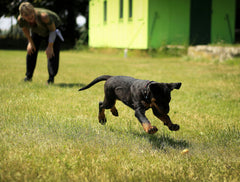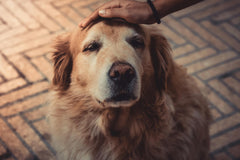
There are many reasons that humans love their canine companions. They’re always energetic, happy to see you, and can be a great source of comfort during difficult times. Like many pets, this can be attributed to the unwavering loyalty they have for their owners so long as they’re treated well. A dog will always be there for you when you need them – they might only be a small portion of your life, but you make up the entirety of theirs.
In many ways, this is why some people heavily prefer dogs over other animals. The seemingly endless sense of love that pours out from them is enough to brighten anyone’s day, especially after those days or weeks that are rough all around. Despite all the good things that come out of this love and dedication for their owners, there is one drawback that can cause great strife for both the dog and its owner.
Separation anxiety in dogs is, unfortunately, a very real and harmful symptom of a distressed dog. Akin to other behavioral problems, dog anxiety symptoms are easy to spot because of how outwardly they tend to display them.
Given the extensive impacts of the coronavirus pandemic, there are bound to be more dogs that will begin to exhibit these same symptoms. They have likely become so accustomed to their owners staying at home that dogs that were otherwise okay are beginning to show signs of anxiety.
Simply knowing that separation anxiety is an issue for dogs is a good start, but it can be difficult to know whether your own dog is suffering from separation anxiety solely based on symptom and guesses. To help you familiarize yourself with all things related to separation anxiety, this piece will outline the primary causes of it, what specific sets of symptoms are commonly seen, and how you can prevent your dog from suffering from this condition.
Causes of Separation Anxiety

There are three primary causes that can be discussed regarding separation anxiety. Each of these plays a different role in the severity of symptoms but has the same overall result.
One cause of separation anxiety is that it is possible the dog has never been left alone for any period before. This cause will likely see the greatest rise once the ‘stay at home’ orders from the pandemic has ended and people begin returning to work. Many puppies have been raised by their owners without them (or someone in the house) having to leave, meaning they have always had someone to be around. However, this problem has been around long before the pandemic and will likely only see greater frequency because of it. Again, it is mainly a result of the dog never being left on their own when they were young, meaning they could never grow accustomed to it.
Another cause is often linked to the dog experiencing some form of trauma throughout their life without their owner being around. This can occur at any time and depends heavily on how much they were initially impacted by such an event. Robberies during the night and abuse through abandonment are the common causes for this form of anxiety, generally found in dogs adopted from animal shelters, and should be approached carefully with love/affection.
Finally, the dog's overall personality, temperament, and breed can tend to play a role in whether they experience separation anxiety or not. There are some lists that outline which dogs are more likely to experience it based on that information than others like the one found here.
Symptoms to Look For

The ASPCA has a full, comprehensive list of the symptoms that can help you identify whether your dog may have separation anxiety. For brevity, here are the ones they have listed that are most common.
Barking and howling are not unusual to hear coming from dogs, though consistency is what’s key here. If your dog constantly barks or howls when you/your family is not home without being prompted, then it is logical they are doing so because they miss you.
Destructive habits can also highlight anxious behavior. There’s a stark difference between playing/making a mistake and a pattern of destruction whenever you leave.
Pacing is a trait not often seen in dogs unless they are stressed or nervous. This becomes easily apparent when someone else is watching your dog and they are still pacing around the room, seemingly restless.
Constantly wanting to escape often signifies they want to get out and find you because the feeling is unbearable. They’ll do whatever they can to get out of your home in order to see where you’ve gone, unfortunately without much success.
Finally, urination and defecation within the house while you’re gone often indicate this condition. This is especially noticeable if your dog is well-trained. They sometimes do it out of fear and anger that you are gone.
Preventative Measures

There are some habits that you can help your dog form that prevents some of these problems altogether. Establishing a routine of you leaving by offering them treats can help them look forward to your comings and goings rather than dreading them.
It doesn’t have to be extravagant, but it also gives them something to focus on that isn’t you, especially if it’s a ‘puzzle toy’ that will keep them busy. Another way to prevent anxiety is to downplay your exits and entrances – greet them with friendliness, but don’t fawn over being overjoyed to see them immediately. Shift that playtime to later in the night.
Finally, you can also focus on training your dogs during the time that you’re with them. You don’t have to train them for long periods during the day, but a half-hour here and there can work wonders in helping your pup.
Conclusion
It may take a bit of time, and the process won’t be easy, but incorporating these practices into your dog’s daily routine could help them greatly. Ultimately, it can enable you to reinforce a peaceful, stress-free life for you and your dog that can lead to a stronger bond between you and them.
How to calm an anxious dog?
What is separation anxiety?
How to treat anxiety in dogs?
Related Posts:
- Why Do Dogs Chase Their Tails: Here Are the Top 5 Reasons
- How CBD Hemp Oil for Dogs Is Becoming A Desire Amongst Consumers
- Mental Health Benefits of Pets: Why Owning a Dog is Good for You




